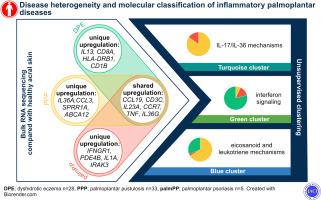炎症性掌跖疾病的疾病异质性和分子分类。
IF 11.2
1区 医学
Q1 ALLERGY
引用次数: 0
摘要
背景:掌跖脓疱病(palmoplantar pustulosis,PPP)是一种炎症性疾病,其特征是手掌和足底复发的充满中性粒细胞的无菌脓疱,临床上很难与非脓疱性掌跖银屑病(palmPP)和潮湿性掌跖湿疹(dyshidrotic palmoplantar eczema,DPE)区分开来:目的:识别重叠和独特的掌跖银屑病、掌跖湿疹和掌跖湿疹驱动因子,从分子角度深入了解其发病机制:我们对病变的PPP(33例)、palmPP(5例)和DPE(28例)样本,以及5例健康非痤疮皮肤样本和10例健康痤疮皮肤样本进行了大量RNA测序:结果:尖锐湿疣皮肤显示出独特的免疫环境,这可能是导致掌跖炎症性疾病的独特原因。与健康的尖锐湿疣皮肤相比,PPP、palmPP 和 DPE 显示出广泛重叠的转录组特征,其特点是促炎细胞因子(TNF、IL36)、趋化因子和 T 细胞相关基因的共同上调,以及每种疾病状态的独特疾病特征,包括 PPP 中丰富的中性粒细胞过程(palmPP 的程度较轻)和 DPE 中的脂质抗原处理过程。令人震惊的是,无监督聚类和轨迹分析显示了三种疾病状态下不同的炎症特征。这些分析确定了可能的关键上游免疫开关,包括二十烷酸、干扰素反应和中性粒细胞脱颗粒,从而导致了疾病的异质性:我们证明了不同炎症性掌跖疾病之间的分子重叠性,这种重叠性超越了临床和组织学评估,但同时也强调了每种疾病内部的异质性,这表明了当前疾病分类的局限性,以及向炎症性角化病分子分类发展的必要性。本文章由计算机程序翻译,如有差异,请以英文原文为准。

Disease heterogeneity and molecular classification of inflammatory palmoplantar diseases
Background
Palmoplantar pustulosis (PPP) is an inflammatory disease characterized by relapsing eruptions of neutrophil-filled, sterile pustules on the palms and soles that can be clinically difficult to differentiate from non–pustular palmoplantar psoriasis (palmPP) and dyshidrotic palmoplantar eczema (DPE).
Objective
We sought to identify overlapping and unique PPP, palmPP, and DPE drivers to provide molecular insight into their pathogenesis.
Methods
We performed bulk RNA sequencing of lesional PPP (n = 33), palmPP (n = 5), and DPE (n = 28) samples, as well as 5 healthy nonacral and 10 healthy acral skin samples.
Results
Acral skin showed a unique immune environment, likely contributing to a unique niche for palmoplantar inflammatory diseases. Compared to healthy acral skin, PPP, palmPP, and DPE displayed a broad overlapping transcriptomic signature characterized by shared upregulation of proinflammatory cytokines (TNF, IL-36), chemokines, and T-cell–associated genes, along with unique disease features of each disease state, including enriched neutrophil processes in PPP and to a lesser extent in palmPP, and lipid antigen processing in DPE. Strikingly, unsupervised clustering and trajectory analyses demonstrated divergent inflammatory profiles within the 3 disease states. These identified putative key upstream immunologic switches, including eicosanoids, interferon responses, and neutrophil degranulation, contributing to disease heterogeneity.
Conclusion
A molecular overlap exists between different inflammatory palmoplantar diseases that supersedes clinical and histologic assessment. This highlights the heterogeneity within each condition, suggesting limitations of current disease classification and the need to move toward a molecular classification of inflammatory acral diseases.
求助全文
通过发布文献求助,成功后即可免费获取论文全文。
去求助
来源期刊
CiteScore
25.90
自引率
7.70%
发文量
1302
审稿时长
38 days
期刊介绍:
The Journal of Allergy and Clinical Immunology is a prestigious publication that features groundbreaking research in the fields of Allergy, Asthma, and Immunology. This influential journal publishes high-impact research papers that explore various topics, including asthma, food allergy, allergic rhinitis, atopic dermatitis, primary immune deficiencies, occupational and environmental allergy, and other allergic and immunologic diseases. The articles not only report on clinical trials and mechanistic studies but also provide insights into novel therapies, underlying mechanisms, and important discoveries that contribute to our understanding of these diseases. By sharing this valuable information, the journal aims to enhance the diagnosis and management of patients in the future.

 求助内容:
求助内容: 应助结果提醒方式:
应助结果提醒方式:


